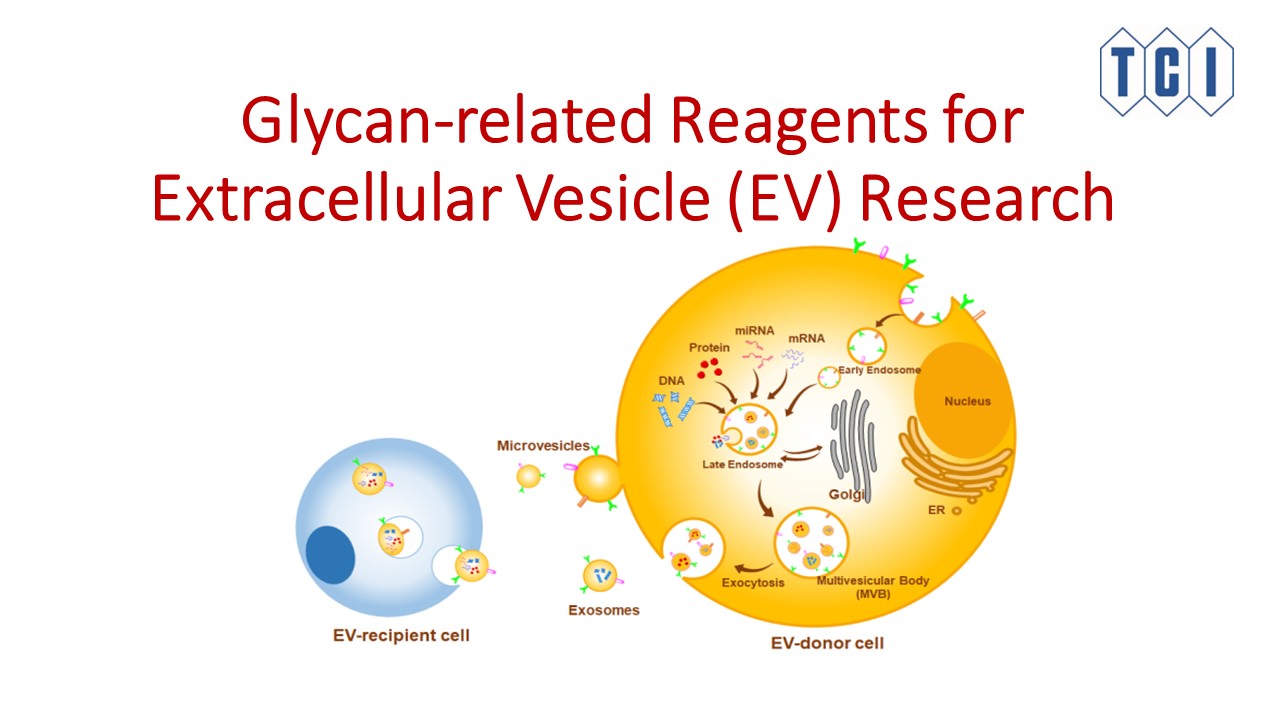Glycan-related Reagents for Extracellular Vesicles (EVs) Research - PowerPoint PPT Presentation
Title:
Glycan-related Reagents for Extracellular Vesicles (EVs) Research
Description:
Extracellular Vesicles (EVs) derived from mesenchymal stem cells are known to have therapeutic potential, with several clinical trials ongoing. EV applications to drug delivery platforms have also been developed. Increasing research efforts in the EV field have yielded an appreciation for the potential role of glycans in EV function. TCI can synthesize various glycans related products to support your research, - For Insertion (chemical synthetic oligosaccharide) - For Detection (antibodies and Lectins) - For Cleavage (Enzymes) – PowerPoint PPT presentation
Number of Views:1
Title: Glycan-related Reagents for Extracellular Vesicles (EVs) Research
1
Glycan-related Reagents for Extracellular Vesicle
(EV) Research
2
Extracellular Vesicles
- Extracellular Vesicles (EVs) are small vesicles
with lipid bilayer that are secreted from various
cells under physiological and pathological
conditions and exist in the body fluids and cell
culture supernatant. - EVs contain nucleic acids and proteins, and act
as mediators of intercellular communication by
entering the target cells. - EVs include subtypes such as exosomes and
microvesicles. - They are involved in many physiological responses
and diseases, including cell differentiation,
immune responses, infection, cancer,
cardiovascular diseases, and neurodegeneration.
3
Extracellular Vesicles
- EVs derived from mesenchymal stem cells are known
to have therapeutic potential, with several
clinical trials ongoing. - EV applications to drug delivery platforms have
also been developed.
4
Glycans
- Glycans exist not only on the surface of cells,
but also on the surface of sEVs (small
Extracellular Vesicles EVs lt200 nm in diameter)
as glycoproteins or glycolipids. - Importance of glycans on EVs has been shown. For
example, glycocalyx on the cancer cell-derived
EVs has been reported to involve in organotropic
determination in cancer metastases. - Glycans on the EV have been reported to play
important role in the tuning of EV uptake. - TCI has many products related to glycans
expressed on the EVs.
5
Glycolipid-related Glycans
- Glycan patterns are well known to change during
various biological events, which include cancer,
inflammatory diseases, and immune diseases, and
the same applies to sEV surface glycans. - TCI can synthesize various glycans on the cell
surface. We offers you oligosaccharides which
play important roles such as intercellular
recognition, adhesion, proliferation control and
signaling.
6
Glycolipids
- Products
7
Glycolipids Products
G0509 a-GalactosylCeramide
G0580 Gb4 Ceramide
G0592 Gb5 Ceramide ( SSEA-3)
G0589 Globo-H Ceramide
G0593 SialylGb5 Ceramide ( SSEA-4)
G0483 Ganglioside GM1
G0489 Ganglioside GM3
G0422 Ganglioside GM3 (phyto-type)
G0510 Ganglioside GM3(Neu5Gc) (phyto-type)
S0910 Sialyl Neolactotetraosylceramide ( Sialyl nLc4Cer)
8
Oligosaccharides
- Products
9
Oligosaccharides Products
G0479 Globotriose
G0403 Gb3-ß-ethylazide
G0402 Gb3-ß-ethylamine
G0623 Gb4-PrN3
G0434 Globopentaose
G0599 Gb5-PrN3
G0596 Globo-H-PrN3
G0447 Globo-H-PrNH2
S0946 SSEA-1-PrNH2
S0849 Sialyl Lewis X-Lactose
N1147 Neu5Aca(2-6)Gal-ß-propylamine
N0950 Neu5Aca(2-6)Galß(1-4)GlcNAc-ß-ethylamine
N1249 Neu5Aca(2-3)Gal-ß-propylazide
N1146 Neu5Aca(2-3)Gal-ß-propylamine
N1267 Neu5Aca(2-3)Galß(1-4)GlcNAc-ß-propylamine
N1258 Neu5Aca(2-3)Galß(1-4)Glc-ß-propylamine
N1259 Neu5Gca(2-3)Galß(1-4)Glc-ß-propylamine
10
Anti-glycolipid Antibodies
- Antibodies are proteins which are one of the
components of the immune system. The specificity
of antibodies is likened to the interaction
between a key and a keyhole. Anti-glycolipid
antibodies can specifically recognize
glycolipids. - TCI mainly produce antibodies against
glycolipids Ganglio-series, Globo-series,
Lacto-series, and Neolacto-series. - These antibodies can be used for
immunohistochemistry, cell-staining, flow
cytometry, ELISA, TLC-immunostaining and other
methods. - Our antibodies are very useful tools for
analyzing the expression of carbohydrate chains
and their functions.
11
Anti-glycolipid Antibodies
- Products
A2505 Anti-GM1 Monoclonal Antibody
A2576 Anti-GM2 Monoclonal Antibody
A2582 Anti-GM3 Monoclonal Antibody
A2507 Anti-GD1a Monoclonal Antibody
12
Anti-glycolipid Antibodies Products
A2508 Anti-GD1b Monoclonal Antibody
A3338 Anti-GD2 Monoclonal Antibody
A2580 Anti-GD3 Monoclonal Antibody
A2702 Anti-GT1a Monoclonal Antibody
A2732 Anti-GT1b Monoclonal Antibody
A2662 Anti-GQ1b Monoclonal Antibody
A2701 Anti-GalNAc-GD1a Monoclonal Antibody (2A3D2)
A2506 Anti-Gb3 Monoclonal Antibody
A2822 Anti-Gb3 Monoclonal Antibody Biotin Conjugate
A2706 Anti-SGPG (HNK-1) Monoclonal Antibody
13
Lectins
- Lectins are highly specific carbohydrate-binding
proteins of nonimmune origin. Due to their
ability to bind with cell-surface glycoproteins
and glycolipids, lectins could agglutinate cells
they also could reversibly associate
polysaccharides and glycoproteins in solution. - Lectin has long been well-known as tools for
detection and analysis of functional
oligosaccharides in the glycoscience field.
Recombinant lectins show better stability
compared with lectins extracted from natural
resources. - TCI offers not only recombinant lectins but also
chemically modified lectins such as several types
of biotinylated lectin and lectin-agarose for
detection and capturing of glycoconjugates.
14
LecBeads (Lectin-Agarose)
- Products
R0235 rPSL1a-LecBeads for Siaa(2-6)Gal
R0236 rLSL-N-LecBeads for Galß(1-4)GlcNAc, poly LacNAc
R0237 rMOA-LecBeads for Gala(1-3)Gal
R0238 rSRL-LecBeads for GlcNAcß(1-2)Man, Galß(1-3)GalNAc
R0239 rGRFT-LecBeads for Mana(1-2)Man
A3331 AOL-LecBeads for Fuca(1-6)/a(1-4)/a(1-3)/a(1-2)
15
Lectin-Biotin Conjugates
- Products
R0230 rPSL1a-Biotin for Siaa(2-6)Gal
R0231 rLSL-N-Biotin for Galß(1-4)GlcNAc, poly LacNAc
R0232 rMOA-Biotin for Gala(1-3)Gal
R0233 rSRL-Biotin for GlcNAcß(1-2)Man, Galß(1-3)GalNAc
R0234 rGRFT-Biotin for Mana(1-2)Man
A2659 AOL-Biotin Conjugate
16
Lectins
- Products
R0225 Recombinant Polyporus squamosus lectin ( rPSL1a) expressed in E. coli
R0226 Recombinant Laetiporus sulphureus lectin N-Terminal Domain ( rLSL-N) expressed in E. coli
R0227 Recombinant Marasmius oreades agglutinin ( rMOA) expressed in E. coli
R0228 Recombinant Sclerotium rolfsii lectin ( rSRL) expressed in E. coli
R0229 Recombinant Griffithsia sp. lectin ( rGRFT) expressed in E. coli
L0169 Lectin, Fucose specific ( AOL) from Aspergillus oryzae
17
Endoglycosidases
- Endoglycoceramidase (EGCase) is a
glycolipid-specific hydrolase that cleaves the
glycosidic linkage between oligosaccharide and
ceramide of various glycosphingolipids (GSLs). - Recombinant EGCase (rEGCase) is activated under a
detergent-dependent condition. In contrast,
Activator II is capable of inducing activity of
EGCases without any detergent reagents. - By the use of Activator II, GSLs on cell surfaces
of living cells could be hydrolyzed without cell
disruption caused by detergent.
18
Endoglycosidases and Related Enzymes
- Products
R0240 rEGCase I
R0241 rEGCase I assisted by Activator II
R0242 rEGCase II
R0243 rEGCase II assisted by Activator II
A1651 Endo-M ( endo-ß-N-Acetylglucosaminidase)
G0365 Glycosynthase ( Endo-M-N175Q)
E1339 Endo-M-W251N
A1844 endo-a-N-Acetylgalactosaminidase (Endo-a)
K0069 Keratanase II

